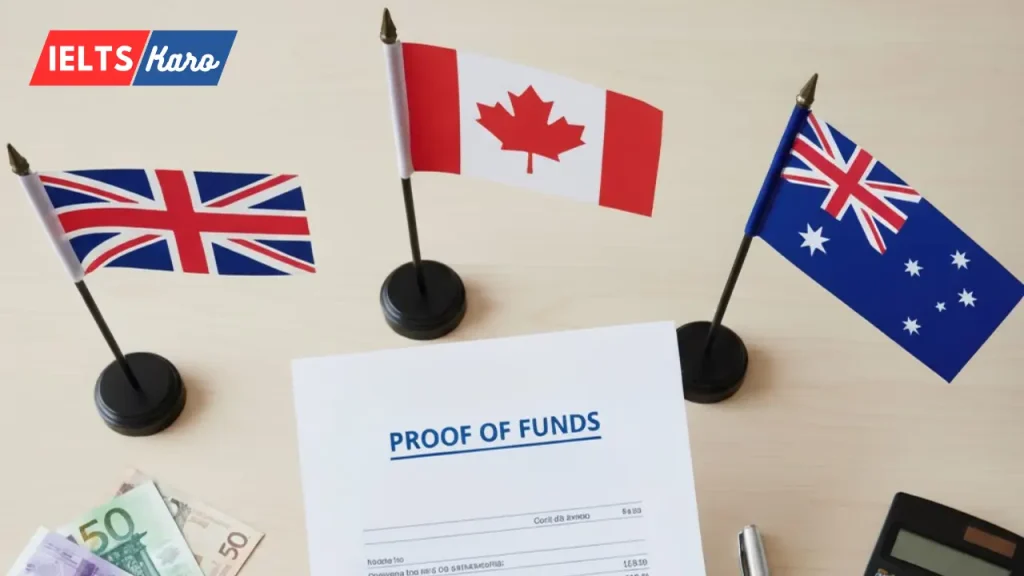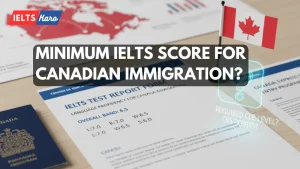I am sharing the most updated and recent figures of 2025 in this blog. It is important however, to verify the accuracy from official government websites as these numbers are subject to change from time to time.
Updated: 14th October, 2025
You have aced your IELTS with a 7.0 band score, prepared your statement of purpose and completed all the required documentation. What next? Now comes the most terrifying part; Arranging financial statements and proof of funds for your student visa. And nothing stresses students out more than the proof of funds requirement.
Immigration officials need assurance that you will not run out of funds during your stay in a foreign country.
I get it. You’re staring at bank statements, calculating exchange rates at 2 AM, and wondering:
“Is this enough? Did I do it right? Will they reject me because of this?”
Here’s the good news; showing proof of funds isn’t rocket science, but it DOES require enormous attention to details. Miss one requirement, and your visa application could get rejected, even if you could afford the tuition.
So let me walk you through exactly what you need for the UK, Canada, and Australia:
But First, What is Proof of Funds?
Proof of funds means that you have substantial proof and documentation that demonstrate your financial ability to pay for your tuition, food, housing, and other costs during your stay in the UK, Australia, Canada or any other country. In short, it shows that you are capable of affording a foreign degree.
Common types of financial proof include but are not limited to:
- Financial statements of personal current/savings accounts showing consistency in balances
- Official payment receipts of university tuition fee
- Official loan approval letters (if any)
- Any sponsorship or scholarship letters (if applicable)
- Guaranteed investment certificates (required for Canada applications)
These financial documents not only show how much money you have in your bank account, but also demonstrate clearly who the money belongs to, and the source of funds.
In almost all cases, funds must be liquid, available in cash, as property, gold, bitcoin, stocks or any other stock is not considered valid for proof of funds.
Why Proof of Funds Matters (And Why Visa Officers Are So Strict About It)
Immigration authorities want to make sure you can actually afford to study and live in their country without running out of money, overstaying or working illegally. They’ve seen far too many students struggle financially, drop out, or overstay their visas because they didn’t have enough funds.
So when they ask for proof of funds, they’re not trying to make your life difficult. They genuinely need to see that you’re financially prepared for this journey.
And trust me, they check EVERYTHING. The dates, the amounts, the source of funds, even the formatting of your bank statement.
Here is a quick comparison for the three top destinations, UK, Canada and Australia:
| Country | Amount Required | Key Requirements | Time Required to Show Funds |
| UK | £1,483/month (London), £1,136/month (outside London) + tuition | 28 consecutive days | Funds must be dated within 31 days of application |
| Canada | CAD $22,895 + tuition + travel | Valid at time of application | Bank statements for last 4 months |
| Australia | AUD $29,710* + tuition + travel | 12 months living costs | Must cover full first year |
*Check the official Home Affairs website for the most current amount as this changes annually.
Now let’s break down each country in detail.
UK Student Visa: Proof of Funds Requirements
How Much Money Do You Need?
The UK has pretty specific requirements based on where you’ll be studying:
If you’re studying in London:
- £1,483 per month for living expenses for up to 9 months
- PLUS your first year tuition fees (or full course fees if less than a year)
If you’re studying outside London:
- £1,136 per month for living expenses for up to 9 months
- PLUS first year tuition fees
Example calculation for London: If your tuition is £20,000:
- £20,000 (tuition) + £13,347 (9 months × £1,483) = £33,347 total
The Critical 28-Day Rule
Here’s where students mess up the most. Your money needs to have been in your account for 28 consecutive days ending no more than 31 days before you apply.
So if you’re applying on October 15th, your bank statement should be dated between September 14th and October 15th, and the money must have been there from (at least) August 18th onwards.
Common mistake: Students deposit a lump sum right before applying. That doesn’t work. The money needs to “age” in your account for 28 days.
What Documents Are Accepted?
The UK accepts:
- Personal bank statements
- Building society bank statements
- Official financial sponsor letter (if applicable)
- Student loan letter from a government, government-sponsored loan company, or regulated student loan scheme
Important Rules for Bank Statements:
- Must show your name (or parent’s/legal guardian’s name if they’re sponsoring you)
- Account number
- Unaltered Bank name and logo
- Transaction history showing the balance has NOT dropped below the required amount for 28 days
- Bank stamp/seal or electronic with official verification
Don’t use business accounts because these documents come with additional verification. Just keep things simple.
Can Your Parents Sponsor You?
Yes! If your parents are funding your studies, they need to provide:
- Their bank statements (meeting the 28-day rule)
- Birth certificate showing your relationship
- Letter from your parent(s) confirming they’ll support you financially
The letter should explicitly state: “I [parent name] confirm that I am the parent of [your name] and will provide financial support for their studies in the UK. I give permission for them to use the funds in my account for this purpose.”
What About Education Loans?
Education loans are accepted! You need:
- Loan approval letter clearly stating:
- Loan amount
- Your name as the borrower
- That the loan is for your studies
- That it will be disbursed to you
- The loan must cover the required amount (tuition + living costs)
Important: The loan approval letter must be dated within 6 months of your application.
Canada Study Permit: Proof of Funds Requirements
How Much Money Do You Need?
Canada’s requirements are straightforward but recently got more expensive.
As of September 1, 2025, you need:
- CAD $22,895 for living expenses (12 months)
- PLUS your first year tuition fees
- PLUS travel costs to Canada
If you’re bringing family:
- Add CAD $4,000 for first family member
- Add CAD $3,000 for each additional family member
Example: Your tuition is CAD $25,000 per year:
- CAD $22,895 (living) + CAD $25,000 (tuition) + CAD $2,000 (travel estimate) = CAD $49,895 minimum
Important: The Provincial Attestation Letter (PAL)
Since January 2024, most students would now need a PAL before applying for a study permit. This is separate from proof of funds, but worth mentioning because it affects your application timing.
What Documents Are Accepted?
Canada is actually pretty flexible here. You can show:
1. Bank statements (last 4 months recommended)
- Personal savings account
- Fixed deposits
- Both yours and your sponsor’s combined
2. Guaranteed Investment Certificate (GIC) This is HUGE for Canadian applications. A GIC from a participating Canadian bank (like Scotiabank, CIBC, ICICI Canada) is golden proof because it shows you’ve already locked away CAD $20,635 specifically for living in Canada.
Many visa officers prefer seeing a GIC because it’s locked, verified, and can’t be withdrawn easily.
3. Education loan approval letter
- Must clearly state the loan amount
- Must show it’s sanctioned and will be disbursed
- Include all loan documentation
4. Proof of paid tuition/housing
- If you’ve already paid tuition, show the receipt
- Pre-paid accommodation confirmation
5. Scholarship letters
- Official letter from university/organization
- Must state scholarship amount and duration
Can Your Parents Sponsor You?
Absolutely. Canada is very parent-friendly. If your parents are sponsoring, provide:
- Their bank statements (last 4 months)
- Proof of relationship (birth certificate)
- Affidavit of support letter
- Their employment proof/income tax returns (helps build credibility)
Showing stable income sources (salary slips, business income) alongside savings makes your application stronger.
The GIC Route: Should You Do It?
If you’re from India, Pakistan, Philippines, China, or Vietnam, seriously consider getting a GIC. Here’s why:
- Visa officers love it (seriously, approval rates are higher)
- It’s a guaranteed, locked fund specifically for Canada
- It shows serious intent
- You get the money released in installments once you arrive in Canada
The process:
- Get admission
- Open GIC account with participating bank (can be done from your country)
- Transfer CAD $20,635
- Receive GIC certificate
- Submit with visa application
Australia Student Visa: Proof of Funds Requirements
How Much Money Do You Need?
Australia calculates everything for 12 months upfront. Here’s the breakdown:
For the student:
- AUD $29,710 for living costs (12 months)
- PLUS your course fees for first year
- PLUS return airfare (approximately AUD $2,000)
If bringing a partner:
- Add AUD $10,394
If bringing children:
- Add AUD $4,449 per child
Example: You’re doing a Master’s with AUD $35,000 tuition, bringing your spouse:
- AUD $29,710 (you) + AUD $10,394 (partner) + AUD $35,000 (tuition) + AUD $2,000 (travel) = AUD $77,104 total
Yeah, Australia isn’t cheap.
Alternative: Show Annual Income Instead
Here’s a lesser-known option. Instead of showing liquid funds, you can demonstrate:
- Your parents/partner had a personal annual income of at least AUD $62,222 in the last 12 months
- With family members: at least AUD $72,592
You’ll need:
- Official income tax documents
- Pay slips
- Employment letters
- Bank statements showing salary credits
This works great for students whose parents have good jobs but might not have lump sum savings sitting in the bank.
What Documents Are Accepted?
1. Bank statements
- Personal savings accounts
- Fixed deposits (must show they’re accessible)
- Parent’s accounts (with proof of relationship)
- Last 3-6 months of statements recommended
2. Education loan approval
- Loan sanction letter showing amount
- Must clearly state it’s for overseas education
- Include disbursement timeline
3. Income evidence (alternative to liquid funds)
- Income tax returns (last 12 months)
- Salary certificates
- Employment contracts
- Bank statements showing regular income deposits
4. Sponsorship letters
- From parents/spouse/relatives
- Include their financial documents
- Proof of relationship
- Notarized affidavit of support
Can Your Parents Sponsor You?
Yes! Australia is completely fine with parental sponsorship. Provide:
- Their bank statements (3-6 months)
- Relationship proof (birth certificate)
- Affidavit of support
- Their income proof (tax returns, salary slips)
Pro tip: If your parents own property or have investments, include valuation certificates and property documents. It adds credibility to your financial background.
What About Multiple Sources of Funds?
Good news—Australia accepts combination funding. You can show:
- Personal savings: AUD $15,000
- Parent’s funds: AUD $20,000
- Education loan: AUD $35,000
- Scholarship: AUD $10,000
Just make sure everything is properly documented and adds up to the required amount.
Universal Tips: Mistakes That Get Applications Rejected
Now that we’ve covered country-specific requirements, let me share mistakes I’ve seen students make across all three countries:
Mistake #1: Last-Minute Deposits
Don’t suddenly deposit a huge amount right before applying. It raises red flags. This is true for all cases, whether it’s a student visa, a business visa, or a tourist visa.
Solution: Build your funds gradually. If you must deposit a large amount, be ready to explain the source (loan disbursement, property sale, inheritance, etc.).
Mistake #2: Borrowed Money That Needs to Be Returned
Many students “borrow” money from relatives just to show funds, planning to return it after getting the visa. After the approval, they return the funds to their original source, and get empty-handed when land in a foreign country, often landing in hot waters.
Don’t do this. Visa officers can ask for additional documents to verify the source of funds. If you borrowed money, show a proper gift deed or loan agreement. Borrowed money that needs to be returned immediately shouldn’t be used as proof.
Mistake #3: Wrong Currency or Outdated Exchange Rates
Always show amounts in the destination country’s currency OR clearly show the exchange rate used. In Pakistan and India, when the home currency devalues, it raises the minimum funds required in the dollar amount. Always have a buffer of at least 10% to account for currency fluctuations.
Mistake #4: Unclear Bank Statements
Your bank statement must clearly show:
- Account holder name
- Account number
- Bank name and contact details
- Complete transaction history
- Opening and closing balance
- Date of statement
- Bank stamp/seal (for physical statements)
Printouts from ATMs? Nope. Screenshots of mobile banking apps? Definitely not. Handwritten statements? Come on.
Mistake #5: Not Accounting for ALL Costs
Students only show tuition money and forget about:
- Living expenses for the full required period
- Health insurance (mandatory in all countries)
- Travel costs
- Dependent costs (if bringing family)
Mistake #6: Inconsistent Information
If you show CAD $50,000 in your visa application but your bank statement shows something different, that’s a problem. Double-check everything.
What If You Don’t Have Enough Money?
International education is expensive, and not everyone has CAD $50,000 or AUD $70,000 sitting in their bank account.
Here are legitimate options:
1. Education Loans
Most countries accept education loans. In fact, they’re quite respected because:
- They show you have a clear plan for funding
- Established banks/institutions have verified you’re credit-worthy
- You’re taking your education seriously enough to invest in it
Popular education loan providers for international students:
- Your country’s national banks
- International student loan providers (Prodigy Finance, MPOWER Financing)
- Government-sponsored education loan schemes
2. Scholarships and Funding
If you’ve been awarded a scholarship or funding:
- Get an official letter stating the amount and duration
- Include terms and conditions
- Show any amounts already received
- This reduces the amount you need to show from personal funds
3. Sponsorship from Relatives
Some countries (especially Australia) accept sponsorship from relatives beyond parents. But you need:
- Proper relationship proof
- Notarized affidavit
- Sponsor’s financial documents
- Clear explanation of why they’re sponsoring you
4. Combination Funding
Mix and match:
- Personal savings: 30%
- Parent’s contribution: 30%
- Education loan: 40%
As long as the total meets requirements and everything is documented, you’re good.
Country-Specific Pro Tips
For UK Applications:
- Apply for your visa as soon as you get your CAS (Confirmation of Acceptance for Studies)
- The 28-day period is non-negotiable. Always start preparing early
- If using a translation, it must be certified
- Keep the money in your account even after applying. You may need to verify it when you land in the UK, or even with a valid student visa, you can be immediately deported if the funds are not shown in your bank account.
For Canada Applications:
- Consider the GIC route as it seriously improves approval chances
- Submit 4 months of bank statements even if only 3 months are required
- Include your parents’ income tax returns even if not mandatory
- Keep proof of fund requirements in CAD to avoid confusion
For Australia Applications:
- Start compiling documents 6 months before applying
- If showing parental income, get a CA certification of income
- Include a cover letter explaining your funding sources clearly
- Keep digital and physical copies of everything
Documents Checklist: What to Actually Submit
UK Checklist:
- Bank statements (covering 28 consecutive days)
- Bank letter confirming balance hasn’t dropped below required amount
- If parent sponsored: birth certificate, sponsorship letter
- If loan: loan approval letter (within 6 months)
- Proof of tuition payment (if already paid)
Canada Checklist:
- Bank statements (last 4 months)
- GIC certificate (highly recommended)
- Education loan approval letter + supporting documents
- Parent’s bank statements + relationship proof
- Proof of paid tuition (if applicable)
- Scholarship letter (if applicable)
Australia Checklist:
- Bank statements (last 3-6 months)
- Fixed deposit certificates
- Education loan sanction letter
- Parent’s income tax returns (last 12 months)
- Sponsorship letter + relationship proof
- Property valuations
- (if applicable)
- Scholarship letter (if applicable)
Final Thoughts: You’ve Got This
I know proof of funds feels like a mountain to climb, but here’s the truth: thousands of students successfully navigate this every year. You’re not alone in this.
The key isn’t having massive amounts of money, it’s about being organized, honest, and thorough with your documentation.
Start preparing early. Gather documents properly. Double-check everything. And if something doesn’t meet the requirements, fix it before applying.
Your dream of studying abroad is worth this effort. That acceptance letter you got? That’s proof you deserve to be there. Now it’s just about showing you’re financially ready.
But Wait—Have You Cleared Your IELTS Yet?
Here’s something students often forget: before you even worry about proof of funds, you need that IELTS score to get your university admission in the first place.
Most universities in the UK, Canada, and Australia require:
- Overall Band 6.0-7.0 (with no band less than 6.0)
- Some top universities or competitive programs need Band 7.0 or higher
IELTS isn’t just a checkbox. It’s your first impression of the university. A strong IELTS score can sometimes even help with scholarship applications, which reduces the financial burden you need to show!
Struggling with IELTS preparation? At IELTSKaro, we’ve helped thousands of students achieve their target band scores and get into their dream universities. Our proven strategies, personalized coaching, and mock tests are designed specifically for students like you who are aiming for the UK, Canada, and Australia.
Here’s How We Help You End-to-End:
1. IELTS Preparation
- Band 7+ focused training
- Speaking practice with expert trainers
- Writing evaluation and feedback
- Realistic mock tests
- Strategies that actually work
2. University Application Support
- Choosing the right universities based on your profile
- SOP and LOR guidance
- Application review before submission
3. Visa Documentation Help
- Proof of funds document review
- Financial documentation checklist
- Common mistake prevention
- Visa interview preparation
We don’t just teach you IELTS—we walk with you through the entire journey from test prep to visa approval.
Book a free consultation today and let’s create your personalized roadmap to studying abroad. Our counselors will:
- Assess your current IELTS level
- Create a study plan for your target band
- Review your financial documents for visa readiness
- Answer all your study-abroad questions
Because getting rejected due to a low IELTS score or a documentation error? That’s not happening on our watch.
Ready to start your journey? Let’s make it happen—together.
Official Sources & References
All information in this guide is based on official government sources (accurate as of October 2025):
UK Student Visa Requirements:
Canada Study Permit Requirements:
Australia Student Visa Requirements:
*Always verify the most current requirements on official government websites before applying.



